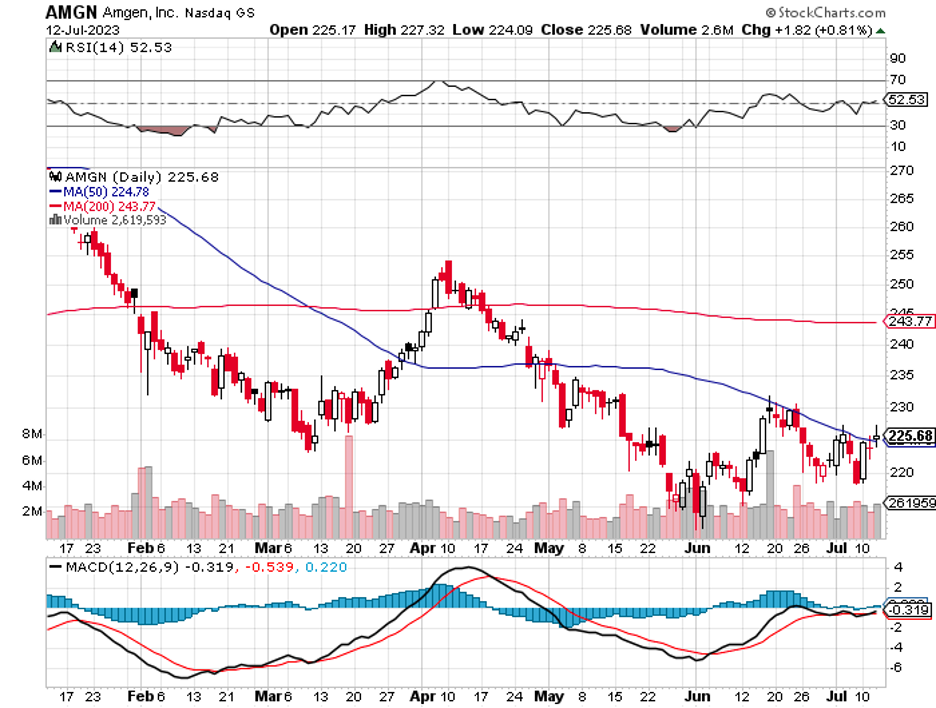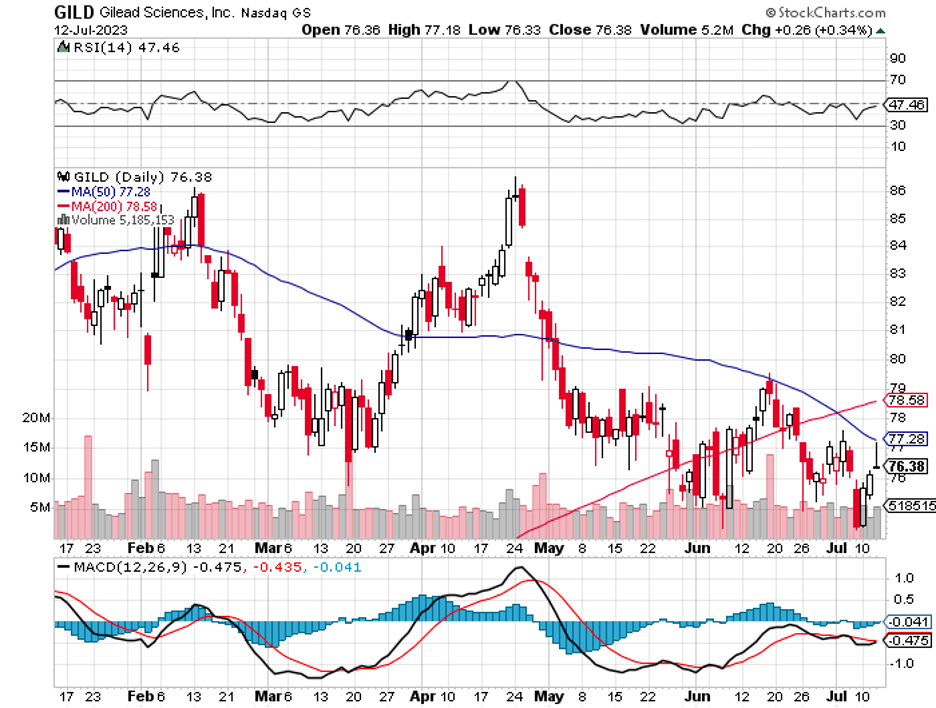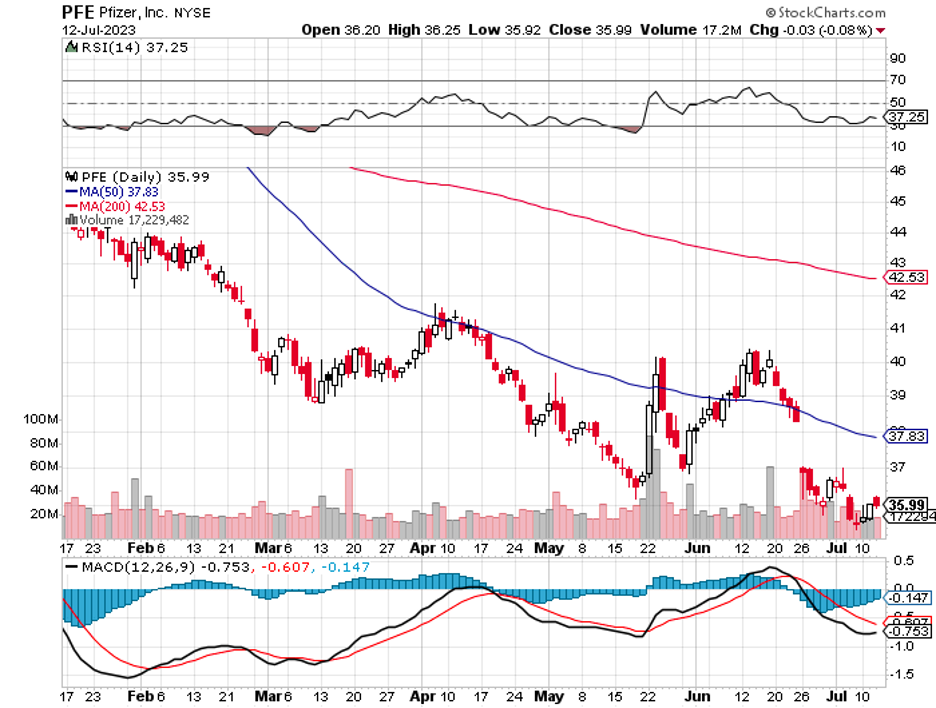The irresistible charm of pharma companies often boils down to their potential pot of gold at the end of the rainbow: the groundbreaking drugs they're tirelessly laboring to introduce. But let's not be reckless.
As appetizing as these stocks may be, they carry a hefty price tag. Moreover, the road to drug development is fraught with unexpected potholes that can leave a nasty dent in the stock's value.
Alternatively, you could pivot to buying a cluster of the more affordable ones.
After all, embracing the tried-and-true philosophy of "a penny saved is a penny earned" can be a winning strategy across diverse sectors, and pharma stocks are no exception.
Here are some options you can explore.
Hovering at $222, Amgen (AMGN) carries a price-to-earnings ratio slightly shy of 12. The firm is grappling with the challenge of a potential few-billion-dollar-a-year dip in sales for some of its drugs while making ambitious strides to enhance its annual revenue of $27 billion.
So far, the most notable beacon of hope for Amgen is its experimental obesity treatments, AMG133 and AMG786, positioned in a market that has the potential to skyrocket beyond a whopping $30 billion annually.
Meanwhile, in a bold move, Amgen has proposed a $27 billion acquisition of Horizon Therapeutics (HZNP).
This strategic takeover could directly bolster Amgen's earnings per share (EPS) by more than $5, significantly enhancing the firm's current annual EPS of $18.
Amgen remains resilient despite facing hurdles from the Federal Trade Commission, which has launched legal proceedings to halt the transaction. The company is not just fixated on Horizon; it has the bandwidth to explore other potential acquisitions or augment its stock buyback program.
Another stock to consider is Bristol Myers Squibb (BMY). Priced at a humble $63, it’s trading at a modest valuation, barely touching eight times its earnings.
The market trembles at the potential stagnation—or worse, reduction—of its annual EPS, currently soaring just above $8. This anxiety is fuelled by the projected multi-billion dollar decline in sales for several drugs as the sands of time run out on their patents. These drugs, after all, form a substantial portion of this year's anticipated revenue of $46.6 billion.
However, it's not all gloom and doom. Bristol Myers Squibb has not one, not two, but a whopping eight new drugs jostling their way through clinical trials. One to keep an eye on is milvexian, a stroke prevention formula that shows immense promise.
These innovative concoctions could eventually inject a stunning $30 billion into the company's annual revenue stream, with the stock potentially reaching an ambitious price target of $85, projecting a handsome upside of 32%.
Gilead Sciences (GILD) is one more stock to take into consideration. Trading at an enticing 11 times earnings, it’s a steal at $76.
Yes, some of its products are on the downhill, but here's the game-changer: Trodelvy, an innovative cancer treatment.
Anticipated to triple revenues, this treatment’s sales is projected to surge from a humble $1 billion this year to a staggering $2.7 billion by 2028.
This suggests an upward trajectory for Gilead's sales, hurtling from just shy of $27 billion this year to well over $30 billion by 2028. The earnings per share (EPS) is poised to see an annual gain of about 6%, potentially reaching nearly $9 by then.
There’s also Pfizer (PFE), priced at a modest $36 and trading just shy of 11 times earnings.
As the dark cloud of Covid-19 gradually disperses, the pharmaceutical titan projects a significant contraction in its annual vaccine sales - halving it down to nearly $14 billion this year, contributing to the overall $67.8 billion income.
But don't be too hasty to dismiss Pfizer's prospects. Its innovation pipeline is teeming with promising solutions like its groundbreaking meningitis therapy. Moreover, it's poised to breathe fresh life into its vaccine division by fusing a flu and Covid vaccine.
Come 2026, the company anticipates its vaccines will arm over 130 million Americans, a notable surge from this year's 79 million recipients of the Covid vaccine alone.
You may find a less treacherous path by adopting a strategic approach of integrating more economically priced pharma stocks into your portfolio.
These stocks may grapple with dwindling sales from established drugs and the relentless onslaught of generic brands.
Nevertheless, they also harbor promising new entrants that, if successful, could spark a significant rally.
All things considered, the companies mentioned above are not mere “cheap” stocks but intriguing opportunities laced with robust potential. I suggest you take advantage of the dip.




